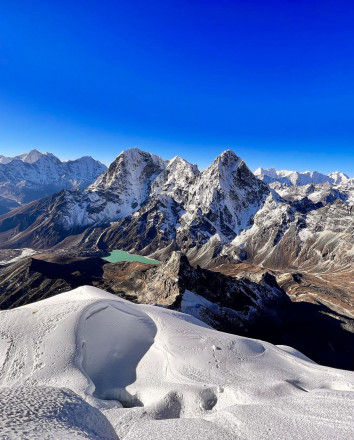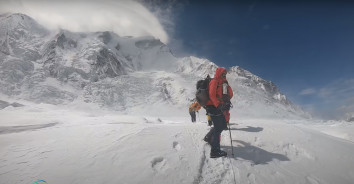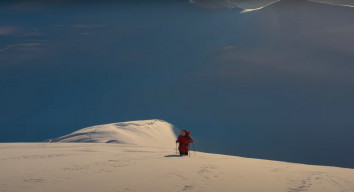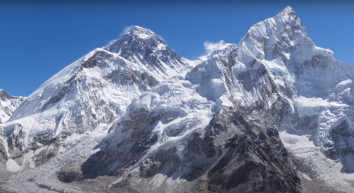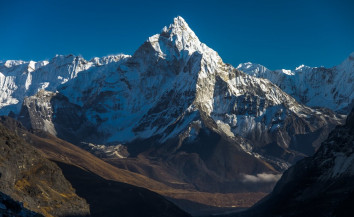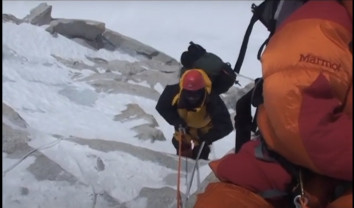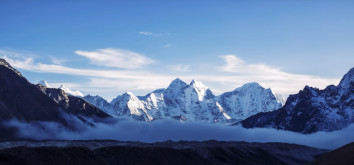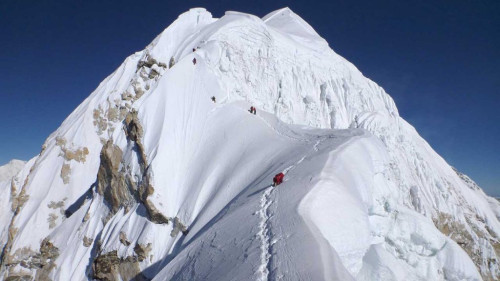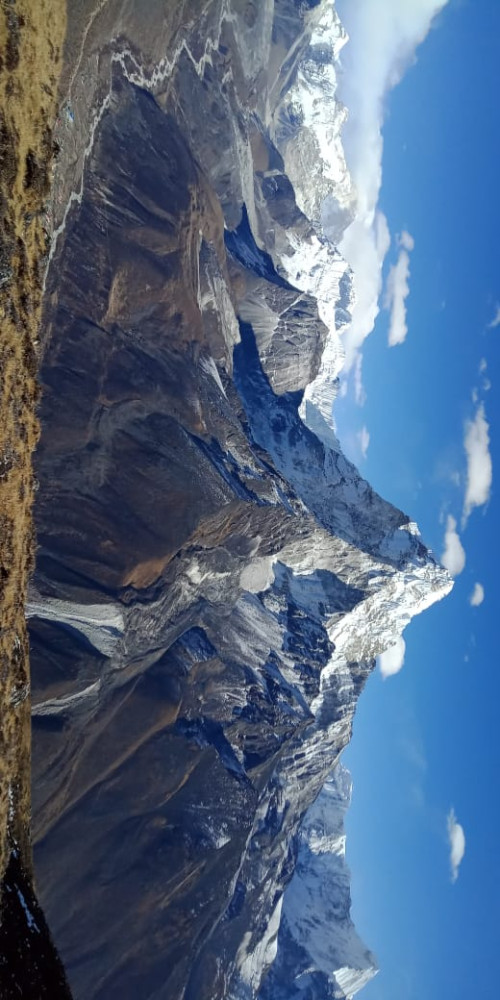Far more technical climb than Everest and other 8,000 metres mountains, the Makalu expedition is a thrill and hurdle for mountaineers. Rising above 8,485 metres, on Makalu Barun National Park and just 20 km South East to Mt. Everest, Makalu is a spectacular facet of 4 distinctive sides.
Before approaching the summit, first, you'll set a journey to the Makalu Base Camp trek after landing at Tumlingtar airport. The last remains of untouched vegetation and alpine meadows of Makalu Barun National Park make the hike serene. The true heaven of this landscape unfolds as we hike for days via Sedua, Num, Shipton La Pass, and Barun River. The appealing glimpses of Chamlang Himal and Makal collectively keep the hike to base camp engaging.
Makalu expedition demands experienced climbers
There's no denying the fact that Makalu is a technical and treacherous climb. The open, knife-exposed climbing ridges and the steep gradient of the summit climb are extremes of the Manaslu expedition. On top, unlike other 8,000ers, climbing the Makalu summit demands the technical abilities of ice and rock climbing. Hence, out of 234 summit attempts, nearly 27 have died during the ascent and descent, making it the 7th deadliest mountain in the world.
History of Makalu Expedition
The world's 5th highest mountain, Makalu, sits in the Mahalangur range. It's an integral part of Everest, Lhotse, and Makalu, where some have often climbed all three in one window in recent years.
But some 70 years ago, in the Spring of 1954, an expedition named California Himalayan Expedition was set for Makalu Expedition. The team led by William Siri, followed by Allen Steck and William E. Long, climbed 7,100 metres near Makalu Camp III when a snowstorm hindered their attempt.
Almost a year after the first successful Everest summit in 1953, Edmund Hillary and his team from New Zealand attempted to climb Makalu in the spring of 1954 but remained unsuccessful. They sustained injuries and illnesses that made them abort the summit climb.
Ultimately, the late Spring of 1954 saw the first successful summit of the Makalu expedition, a French Expedition Team led by Lionel Terray and Jean Couzy. The following day on the 16th of May, 1955, Gyalzen Sherpa, Guido Magnone, and Franco from the French team became the second team to scale the Makalu summit. Andre Vialatte, Pierre Leroux, Jean Bouvier, and Serge Coupe were the climbers to reach the Makalu summit on the 17th of May, 1955.
Makalu expedition- Route to summit
There are two preferred Makalu summit routes, the NorthWest and Southeast Ridge. The climbing route becomes stiffer and steeper as you climb further higher. On leaving the Base Camp, you'll hike on comfortable glaciers and steep blue ice and snow terrains above Camp IV. The continuous climb on steep ridges in other seasons than Spring is often riskier than it usually is.
The fresh and deep snow in Spring lowers the chances of rockfalls and avalanches. World Expedition Nepal sets up four High Camps and one Advanced Base Camp. Camp I and II will be used for acclimatisation climb and rotation until you adapt to the environment. The summit push will be directly from Camp II to Camp III and staying at Camp IV for rest before pushing the summit.
Makalu Advanced Base Camp at 5,600 metres
We'll set Advanced Base Camp over the rocky surface of glacier moraines that offers the inspiring panorama of the Makalu region.
Here, our Sherpa guides will train you and take you to acclimatisation rotation, gear checks, and proper rest. Our full board service includes meals and accommodations at Advanced Base Camps. The kitchen, bathrooms, and personal tents for the accommodation of climbers from World Expedition Nepal will be properly set up and managed by the Makalu expedition crew.
As an homage, Sherpa will organise a Pooja ceremony to the mountain god, asking for permission to climb and the success of the Makalu expedition.
Makalu Camp I at 6,400 metres
After leaving Advanced Base Camp, you'll experience the arduous demand of Makalu. Climbers have to navigate through the gradient ice-snow walls with the aid of fixed lines till Camp I. Our Sherpa will fix the rope long before we leave the Advanced Base Camp.
The setting of Camp I will be on top of the glacial plateau, where members from another expedition team will be in proximity. There'll be two nights of stay at Camp I for better acclimatisation.
Makalu Camp II at 6,600 metres
The climb from Camp I at 6,400 metres to Camp Ii at 6,800 metres is the easiest and shortest climb in the entire Makalu expedition. For experienced climbers, it only takes one and a half hours to reach Camp II from Camp I.
Some sections en route to Camp II demand the use of Jumar, but otherwise, you'll walk by clipping the fixed rope to be cautious from crevasses.
Camp II sits on a 300-metre flat terrain, slightly inclined, at 6,600 metres. Most climbers climb to Camp II straight without stopping at Camp-I for day two during acclimatisation rotation and the summit day.
Makalu Camp III at 7,400 metres
As you climb further, the more technical the climb becomes. The climb II to Camp III now gets technically arduous as you'll climb past the steeper open snow slopes, so deep that it may cover the crevasses and is prone to avalanche.
The French route, the route to Camp III via Makalu La and NorthWest ridge, consists of the terrain of blue ice and rocks. Thus, climbing the assorted terrain of blue ice and rocks till Makalu La at 7,450 metres, walking past 200 metres of the flat icy surface, takes us to Camp III at 7,400 metres.
The selection of an apt fixed-line and navigating through rocky terrain to Camp III drains climbers, mentally and physically.
Makalu Camp III to summit, 8,485 metres
Besides few, most climbers climb the summit directly from Camp III after a couple of hours of sleep. The most experienced climbers also take nearly 8 hours to reach the summit. For inexperienced climbers, it may take ten hours to scale the summit.
The navigation on blue ice becomes a hurdle before climbing a steep ridge. The climbing section hardly has any resting places besides one or two plateaus.
It takes around 20 minutes to reach the actual Makalu summit from the false summit. Most climbers climb to the false summit and can't progress further. But, World Expedition Nepal will have fixed lines till the false Makalu summit, and our Sherpa will take you to the actual Makalu summit.
The rewarding summit of Makalu offers magical glimpses of Everest and Lhotse, with countless mountains in sight.

 Recommended On
Recommended On
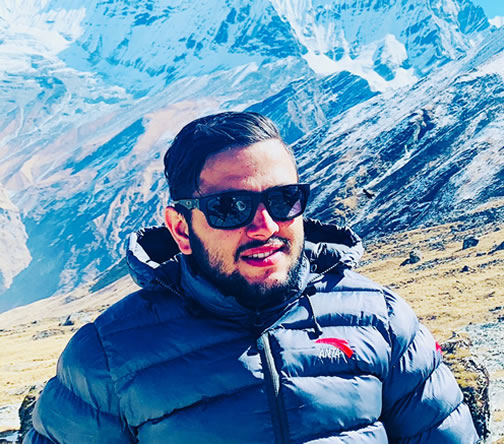




 8000m Peak Climbing , Nepal
8000m Peak Climbing , Nepal  66 Days
66 Days  US$31000
US$31000
